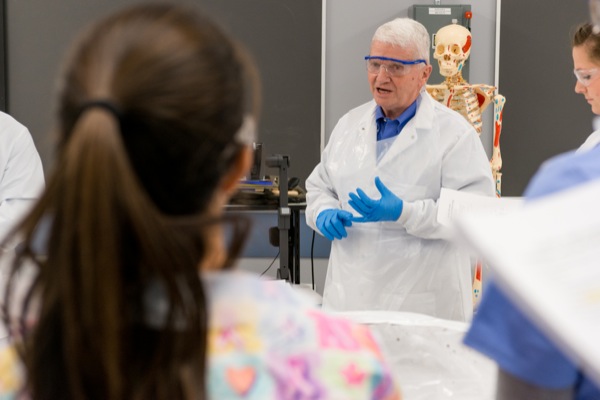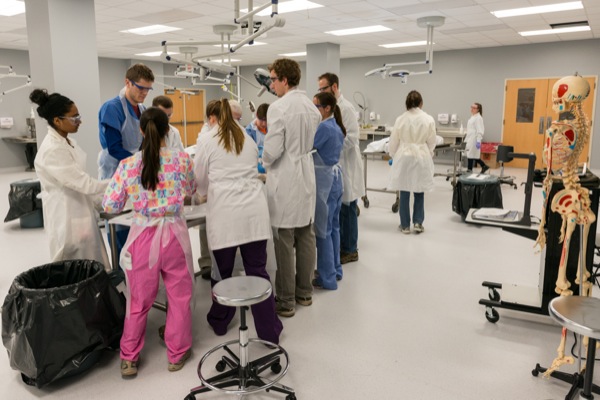


Gifts of life
UD students learn unforgettable lessons in state-of-the-art anatomy lab
2:04 p.m., April 4, 2014--It’s a Monday evening. Ten undergraduate students, two teaching assistants, and a professor are getting ready to work in the anatomy lab at the Health Sciences Complex on the University of Delaware’s new Science, Technology and Advanced Research (STAR) Campus.
The room features gleaming stainless steel tables, surgical lighting, projection equipment for distance learning, and a variety of health and safety features including drainage and ventilation systems and formaldehyde detectors. There are also enough electrical outlets for every student to plug in a laptop.
Campus Stories
From graduates, faculty
Doctoral hooding
With the building just opening in January, this class is among the first to use the new facility, which replaces a lab in the basement of McKinly Hall.
The students gather in groups of four around three dissection tables, scalpels in hand. Tonight, they’re examining the upper chest area of the cadavers they’ve been working on for the past few weeks. Dave Barlow, associate professor, explains that they’re going to be identifying the brachial plexus, the network of nerves that sends signals from the spine to the shoulders, arms, and hands.
These undergrads are all headed for medical school, physical therapy school, or physician assistant school. Working on cadavers will eventually become routine for them, but right now, it’s still relatively new.
“Their initial reaction is usually aversion,” Barlow says. “But then they go through three fairly predictable phases. First, they relate the cadaver to a relative or someone they know. After a while, it becomes simply a biological exhibit. Finally, though, they re-spiritualize the cadaver when they realize that it has taught them things they’ll never forget. That’s when it becomes a tremendous gift.”
Joe Zeni, an assistant professor in UD’s Department of Physical Therapy, understands that gift. The department’s anatomical donor program is the only one of its kind in the state. “In the past,” he says, “we were limited by space constraints, and we had to turn people away. Now we can accommodate a larger number of donations, which is a tremendous gift to our students.”
Zeni also views the lab itself as a gift to faculty and students alike. “Our anatomy lab is the only facility of its kind in the state of Delaware,” he says. “No textbook, anatomical chart, or computer program can substitute for the use of human bodies. And with this facility, we can bring more knowledge to more students. For example, dissections or mock surgeries performed in the lab can be video recorded for later viewing or immediately projected on the screens of the STAR classrooms.”
Jacob Capin, who is earning both a doctorate of physical therapy degree and a Ph.D. in UD’s interdisciplinary Biomechanics and Movement Science program, had the opportunity to tour the anatomy lab with clinicians before the facility opened.
“When we first went in, we were just amazed at all the features and in awe of how incredible this lab is,” he says.
Zeni points out that while the lab is used primarily for education, it has the potential to be used for other activities, including research and biomaterials testing. In addition to the undergraduate class taught by Barlow, the facility is used to teach two graduate-level classes — clinical gross anatomy and advanced regional anatomy.
“My classmates and I feel extremely lucky to have access to the new anatomy lab on the STAR Campus,” says Conor Cahalan, a senior majoring in exercise science. “Most of us weren't expecting to experience a facility and curriculum like this until medical, PT, or PA school. For me, while this may be the toughest class I've ever voluntarily chosen to take, the in-depth understanding of anatomy that I'm getting will be extremely helpful to me down the road as I apply to physician assistant school.
“Also, regardless of our respective paths, we know that this background will make graduate school anatomy — a previously daunting, sometimes overwhelming hurdle for future health providers — significantly more manageable.”
Senior biology major Christine Dang agrees.
“The new STAR facility is phenomenal,” she says. “It’s perfectly set up for graduate and undergraduate studies in the future, and I’m excited to see it grow. I’m heading off to medical school in the fall, so this class is perfect for my planned career — I’ll be very well prepared for my gross anatomy class there.”
Article by Diane Kukich
Photos by Evan Krape and Kathy F. Atkinson









